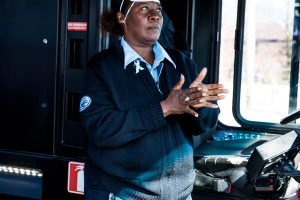Desperate families face risky job offers, dubious loans, and online predators.
The COVID-19 pandemic is making the world worse in lots of ways. One of the more unexpected ways is that the already difficult task of ending modern slavery is even more challenging. With the pandemic expected to drive at least 70 million people into extreme poverty, according to a recent World Bank estimate, desperate workers will be more likely to accept risky job offers or high-interest loans to survive, only to end up trapped in exploitative situations. Companies, anxious to ramp up production after months of lost income, may be more willing to hire the cheapest labor available, including from unethical recruiters, and to skip labor inspections and other oversight measures—thereby enabling human traffickers to thrive.
The pandemic-related global economic meltdown should be no excuse to look the other way. Beyond being rightfully condemned as a grave affront to human rights and dignity, human trafficking also weakens economies and threatens global security. Forced labor affects 25 million people and produces an estimated $150 billion annually, making it one of the world’s most profitable crimes. This practice bankrolls criminal organizations, supports terrorist and armed groups, enables abusive regimes, and undermines stability. Where trafficking flourishes, our collective safety and prosperity flounder.
As countries scramble to mitigate the extensive harm caused by the COVID-19 pandemic, leaders should ensure the most vulnerable in their societies do not fall prey to exploitation. Attention should be paid first to trafficking survivors—72 percent of whom are women and girls. In recent months, domestic workers—many living in slavery-like conditions—have experienced increased physical and sexual violence, decreased wages, and confinement in the home. In parts of the Middle East, for example, exploiters withhold victims’ documentation, preventing them from returning to their home countries. Where border closures are blocking travel, survivors who escape their traffickers find themselves stranded. In the Ivory Coast, for example, the Fuller Project’s Shola Lawal and Corinne Redfern reported on a group of Nigerian women who fled the brothel where they were held captive and are now trapped in a shelter, as Nigeria’s travel restrictions prevent their return home. The pandemic is also taking a toll on the social services that support—and help identify—people who have survived trafficking: A recent OSCE and UN survey of organizations working in 102 countries found that many fear that the diversion of funding and attention away from anti-trafficking responses will force them to close their shelters, without which survivors risk homelessness and further exploitation.
For children around the world, meanwhile, global school closures increase their risk of exploitation. Children are spending more time on the internet for school work and social interaction, and traffickers are increasingly targeting them for sexual exploitation online. There was a 200 percent spike in posts on child sex abuse forums between February and March, combined with a nearly 90 percent drop in the amount of child abuse material removed from the internet, as investigators struggled to keep pace due to reduced staff capacity and the closure of hotlines used to report abuse.
Out-of-school children are at further risk of forced labor due to their families’ economic stress
Out-of-school children are at further risk of forced labor due to their families’ economic stress
. The United Nations predicts that the combination of stay-at-home orders, economic vulnerability, and disrupted prevention programs will contribute to 13 million more child marriagesaround the world (a form of modern slavery), as families force adolescent girls to marry early as an economic safety net.
For migrant workers—already vulnerable to trafficking and exploitation—the COVID-19 pandemic is only compounding their risk. As mass layoffs cost migrant workers their essential daily income, those already on the edge of poverty are left with little ability to buy food and scant or no access to health care and social services. Their debts continue to accumulate, and their families at home, reliant on wages they are no longer sending back, become more desperate. Together, these factors increase the likelihood that migrant workers will accept potentially fraudulent job offers to survive. Already, one in four victims of forced labor was a migrant worker before the pandemic; now, many more are potentially vulnerable to trafficking and exploitation.
Indeed, as economies reopen and production ramps back up, companies and policymakers can anticipate—and should plan for—an increased potential for forced labor. Pressure to meet heightened demand will incentivize companies to take shortcuts and save costs that risk exacerbating modern slavery. Labor abuse has already been documented to match the skyrocketing demand for personal protective equipment, or PPE.
How leaders address the pandemic’s effects on those at greatest risk for exploitation and human trafficking will shape the future of our economies and societies. As the private sector rehires workers and labor migration rises to pre-pandemic levels, businesses have an opportunity to modernize laborrecruitment to increase safety, transparency, and efficiency— checking corruption and reducing the risks of forced labor. It is likewise essential that governments strengthen and enforce regulations for labor migration and ethical recruitment (in addition to broader regulations to prevent trafficking, such as those that protect domestic workers and address online exploitation). To hold traffickers accountable and block their profits, law enforcement should partner with the financial sector to identify and interrupt the illicit financial transactions of traffickers.
National efforts to strengthen social safety nets to assist communities affected by COVID-19 can simultaneously prevent workers and families in economic distress from accepting exploitative situations, for themselves or their children. To realize this benefit, governments should ensure that at-risk communities have access to basic services, from healthcare and cash transfers to credit and low interest rates, regardless of their recent employment history or legal status. And to protect survivors of trafficking, governments should guarantee the availability of hotlines and safe accommodation that allow for physical distancing during the pandemic—in addition to longer-term support for survivors’ reintegration in society.
Human trafficking thrives on poverty and vulnerability, both of which are growing exponentially during the COVID-19 crisis. But as the pandemic wreaks havoc on society, it also creates an opportunity for leaders to “build back better”—to make their countries safer and more equitable for all, and in so doing, finally end modern slavery.




